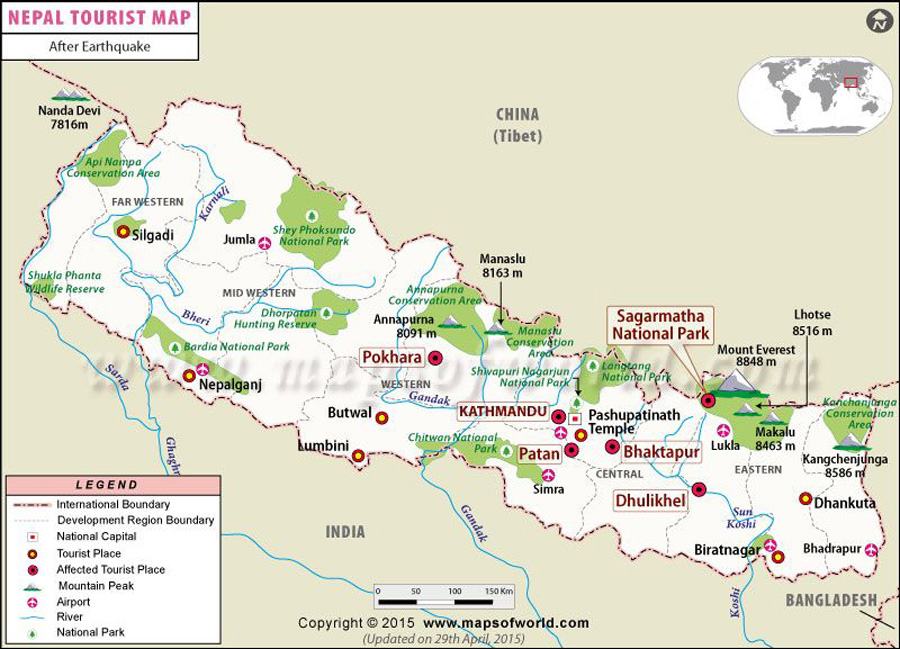Nepal Information
Nepal, officially known as Federal Democratic Republic of Nepal, is landlocked country in south Asia. It is located in the lap of Mt. Everest and paradoxically famous for the Gautam Buddha and the Brave Gurkhas, the battlers. It is the 48th largest county by population and 93rd largest by the area. Its estimated population is 26.4 million (National Census, 2011) and 147,181 square kilometers. It borders China in the north and India in the south, west and east. Geographically, Nepal is of roughly trapezoidal shape 800 kilometres long and 200 kilomitres wide. Nepal is commonly divided into three physiographic areas: the Himalayan, mountain/hills and terrain regions. The ecological belts run east-west and are bisected by Nepal’s major river systems.
The terrain bordering India is a part of the northern rim of the indo-Gangetic plains. they are formed with three major rivers such as the Koshi, the Narayani, and the Karnali. This region has a hot and humid climate.
Nepal has a diverse geography, including fertile plains, subalpine forested hills, and eight of the world’s ten tallest mountains, including Mt. Everest, the highest peak on the earth. Kathmandu is capital city of the nation and Nepali is official language though mother tongue of various ethnic groups and English in elite class is widely preferred.
By the 18th century, the Gorkha kingdom was unified and identified as Nepal. It was never colonized. Now, Nepal is known as federal secular parliamentary republic with seven provinces. It has revived from its civil war (1990s-2000s) and earthquake 2015. Nepal was admitted to the United Nations in 1955 and friendship treaties with most of the nations in the world.
Nepal, officially known as Federal Democratic Republic of Nepal, is landlocked country in south Asia. It is located in the lap of Mt. Everest and paradoxically famous for the Gautam Buddha and the Brave Gurkhas, the battlers. It is the 48th largest county by population and 93rd largest by the area. Its estimated population is 26.4 million (National Census, 2011) and 147,181 square kilometers. It borders China in the north and India in the south, west and east. Geographically, Nepal is of roughly trapezoidal shape 800 kilometres long and 200 kilomitres wide. Nepal is commonly divided into three physiographic areas: the Himalayan, mountain/hills and terrain regions. The ecological belts run east-west and are bisected by Nepal’s major river systems.
The terrain bordering India is a part of the northern rim of the indo-Gangetic plains. they are formed with three major rivers such as the Koshi, the Narayani, and the Karnali. This region has a hot and humid climate.
Nepal has a diverse geography, including fertile plains, subalpine forested hills, and eight of the world’s ten tallest mountains, including Mt. Everest, the highest peak on the earth. Kathmandu is capital city of the nation and Nepali is official language though mother tongue of various ethnic groups and English in elite class is widely preferred.
By the 18th century, the Gorkha kingdom was unified and identified as Nepal. It was never colonized. Now, Nepal is known as federal secular parliamentary republic with seven provinces. It has revived from its civil war (1990s-2000s) and earthquake 2015. Nepal was admitted to the United Nations in 1955 and friendship treaties with most of the nations in the world.
Nepal with terrain of Himal, hills and terain has various stunning routes for trekking, hiking and tours. Each route is the best on their own way. You can find them the best treks that suit you the best depends on your choice, difficulty you want to face, number of days you spend for treks, the budget you want to spend, the style/ facility you want to celebrate and your preferences.
Nepal with terrain of Himal, hills and terain has various stunning routes for trekking, hiking and tours. Each route is the best on their own way. You can find them the best treks that suit you the best depends on your choice, difficulty you want to face, number of days you spend for treks, the budget you want to spend, the style/ facility you want to celebrate and your preferences.


